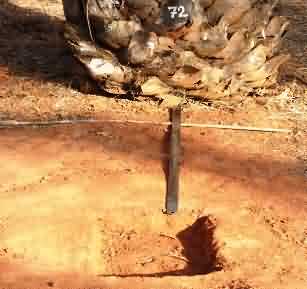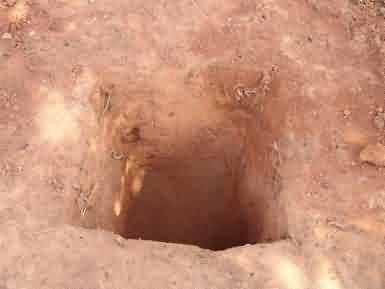तेल पाम वृक्षारोपण में मिट्टी के नमूने एकत्र करने के लिए सटीक विधि
Oil palm is a heavy feeder of nutrients as it produces a very high biomass. Input management plays a major role in plantation crops as the crop remains in the field for a longer period of time. In oil palm plantations fertilizer management proved to play a major role in defining yield potential in terms of Fresh Fruit Bunches (FFB).
Soil analysis is an effective method to determine plant nutritional status for suitable fertilizer application. This includes the collection of representative sample from the soil, estimation of nutrient status and other parameters, calibration and interpretation of analytical results and giving fertilizer recommendations. Proper recommendation can reach the farmer only when precision is maintained at all the stages of analysis.
The first among them is soil sampling upon which the entire programme will be dependant. Hence, employing the correct procedure for sampling the soil makes it essential for correct estimations and thereby obtaining corresponding fertilizer recommendations. Generally, soil samples are collected for assessing the properties like soil reaction (pH), electrical conductivity (EC), organic carbon (OC) content and available nutrients like nitrogen (N), phosphorus (P), potassium (K), calcium (Ca), magnesium (Mg), zinc (Zn), copper (Cu), iron (Fe) , manganese (Mn) and boron (B) in soil.
When to take soil sample ?
Normally, soil samples need not be collected on a particular day. They can be collected on any normal day provided there is no heavy rainfall or irrigation on that day and also it is better to avoid the days which are extremely dry. It is better to wait up to 2 or 3 months after fertilization and at least 2 or 3 days after rainfall is received.
Number and frequency
While collecting soil samples care must be exercised to see that the samples collected should be representative of entire field and should avoid some extreme conditions in order to make the analysis error free.
As a first step in this direction, the larger areas of land may be divided into appropriate number of smaller homogenous units for better representation of the soil nutrient status. For this purpose, certain factors like similarity in yield, soil type, planting date, topography, cropping system, irrigation source etc may be used while deciding the number of sampling units.
Some factors like slope, degree of erosion, drainage, crop and/or manure history etc may influence soil nutrient levels. In general, a sampling density of 1% is recommended for a homogenous sampling unit. That means in a homogeneous unit of land, one percent of the land has to be sampled for the collection of soil. In a particular plantation, soil sampling may be done at 2 years interval to maintain the soil in optimal condition.
While collecting the samples, care must be taken to avoid marshy tracts and areas near trees, recently fertilized spots/palms, bunds, channels, wells and compost pits. Regular soil sampling and analysis can help in diagnosing nutrient deficiencies at initial stage itself and this can help us in taking corrective measures at the earliest without losing any time.
How to collect the Soil sample ?
Oil palm roots are mostly concentrated up to a depth of 50 to 60 cm. The availability of nutrients may vary at different soil depths. So, it is advised to collect the samples from different depths viz., 0 to 20 cm, 20 to 40 cm and 40 to 60 cm. These samples are to be collected from oil palm basins from a place which is 1m away from the base.
For this purpose, a pit of 60 cm x 60 cm x 60 cm size is to be made. Before making the pit, the surface of the soil should be cleaned by removing dry grasses, debris or any other material present on the soil surface. Then, about 2 cm thick slice of soil is taken out uniformly from one clean side.
Soil sampling pit point (1m away from palm base) Pit of 60 cm x 60 cm x 60 cm size
How much soil to collect?
Once the soil sample is collected from three different depths of the pit, all the collected soil is to be thoroughly mixed in a clean plastic container. After that it is to be made as a heap and it has to be apportioned into four.
The opposite two parts are to be rejected and the remaining two parts are to be selected. This is called “quartering” and by this process the sample quantity can be reduced to required level of 500g by repeated quartering.
Soil Sampling tools
Stainless steel soil sampling auger is commonly used for collecting soil samples under normal conditions. Other requirements include plastic buckets, shovel or spade, sample bags (preferably new polyethene bags) and marker pens. Tools should be clean, free of rust and stored away from fertilizer materials. It is advisable not to use galvanized iron or brass equipments or any kind that will contaminate the samples with micronutrients.
Drying of soil samples
Once the samples are collected from the field they need to be dried to remove the moisture before bagging. For this purpose they can be spread on a clean plastic sheet and dried under shade for one or two days and then bagged to send to the Soil Testing Laboratory.
Labeling the soil samples
The following information is to be written on the bags while sending the samples for analysis.
- Name of the farmer
- Address and phone no.
- Date of sampling
- Sampling depth
- No. of samples collected per hectare
- Palm no.
- Past cropping history
- Quantity and date of fertilizer last applied
- Irrigation method and frequency
10. Last three years of fresh fruit bunch yield/ha
Do s and don’t s in soil sampling
Do’s
- The augurs used for sapling must be rust free. Better to use stainless steel augurs.
- Samples need to be stored in clean, preferably new polythene bags.
- For longer duration storage use glass or porcelain or polythene jars.
Dont’s
- Avoid using old bags or card board board boxes which were used for storing fertilizers or other chemicals previously. Because the results can be erroneous while estimating the nutrient status.
- Contact of the soil samples with chemicals, fertilizers and manures should be avoided.
- Soil samples should not be collected immediately after the application of fertilizers or giving irrigation or after a heavy rainfall.
Authors:
1K.Manorama, S.K.Behera, K.Suresh, K.Ramachandrudu, B.N.Rao and M.V.Prasad
Directorate of Oil palm Research, Pedavegi, West Godavari Dist, Andhra Pradesh
1Email:


